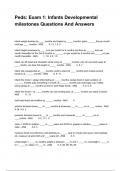Peds: Exam 1: Infants Developmental
milestones Questions And Answers
infant weight doubles by ____ months and triples by _____ months; gains ______ lbs per month
until age ____ months - ANS 6, 12, 1.5, 5
infant height increases by ____ inch per month for 6 months and then by ______ inch per
month thereafter for the 2nd 6 months or ______ cm per month for 6 months and ______cm per
month thereafter - ANS 1, 1/2, 2.5, 1.5
infant can lift head and shoulders while prone at _______ months; can roll over both ways at
____ month, can bear full weight at _____ months - ANS 3, 5, 7
infant sits unsupported at ____ months; pulls to stand at ____ months and cruises around
furniture at ______ months - ANS 8, 9, 11
infant fine motor = grasp reflex fading at _____ months--keeps hand in open position; at
_______ months puts everything in mouth; at _______ months can hold sippy cup / bottle;
pincer grasp at ____ months so time to start finger foods - ANS 3, 4, 6, 9
infant fine motor = at _____months can use nesting toys; at _____ months can stack 2 blocks -
ANS 11, 12
hold head erect and midline by ______ months - ANS 4
anterior fontanel closes ___ to ____ months & measures ___ to ____ cm or ____ inches - ANS
9-18, 4-5, 2
posterior fontanel closes at ___ to ___ months and measures _____ to ______ cm or
____inches - ANS 2-3, .5-1, .5
vision = 20/50 in children ____ to ____ years and 20/30 or greater in children ______ years or
older - ANS 3-4, 5
measure head circumference until birthday at ______ year or if head size issue--microcephaly
etc, measure at well-child until ___ years old - ANS 3, 6
underweight < _____%; healthy weight is between ____% and <_____%, overweight = _____%
to < _____%; obese >/=____% - ANS 5, 5, 85, 85, 95, 95
, normal median systolic pressure (50th%) = ______mm Hg + (____*age in years); low normal
systolic blood pressure (5th%) = _____ mm Hg + (____* years in age) - ANS 90, 2, 70, 2
average diastolic BP using auscultation: 1-5 years = _____ and 6-18 years= age in years +
______ - ANS 56, 52
measure infant & toddler vital signs in which order: BP= _____, respirations = ________, apical
pulse = ______, temperature = _______ - ANS 3rd, 1st, 2nd, 4th
approaches to performing physical assessment: ________ = sit on lap, use distraction; _______
= stranger anxiety, use play, praise cooperation; ________ = magical thinking, give choices;
_______________ = eager to learn, explain equipment, teach about body, provide privacy;
_______ = prefer straightforward, ensure privacy & confidentiality - ANS infants, toddlers,
preschool, schoolagers, adolescents
Systolic BP = _____ to ______ mm hg higher in thigh than in arms at > 1 year; Diastolic
remains same - ANS 10-40
pulse pressure = unusually wide--more than ____ mm Hg; pulse pressure narrow = < ______
mm Hg - ANS 50, 10
calculate length of infant / toddler in lying position until age _______ months; measure standing
height once child is independent and cooperative; calculate weight to length from newborn to
_______ months - ANS 24, 36
bladder capacity newborn = _____ ml - ANS 30
expected urine output in infant and children = _______ to ______ ml/kg/hour; it decreases with
age - ANS .5-2
expected urine output for adolescent = ______ to _____ ml/day - ANS 800-1400
toddlers void ____ to ____ times per day and by age 3 they void _____ to ______ times per day
- ANS 9-10, 3-10
spine is rounded in newborns; lumber curve forms at ______ to ______ months - ANS
12-18
newborns lose up to ____% body weight in 5 days (avg BW = ______lbs.) Newborns regain BW
by ____ to ______ days - ANS 10, 7.5, 10-14
birth weight doubles by ____ to ____ months; triples by _____ months; quadruples by ______
months - ANS 4-6, 12, 30




